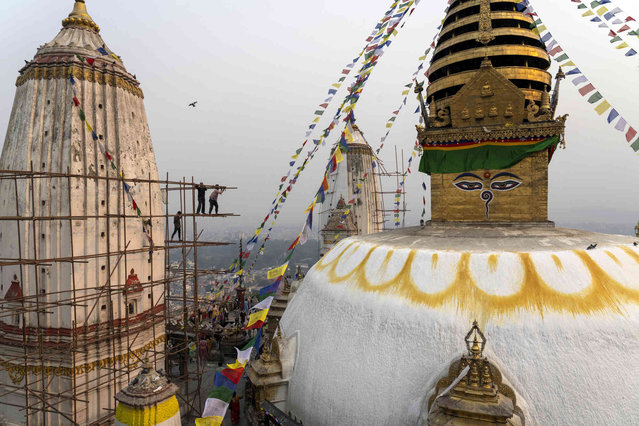
A construction crew works on a temple spire at the Swayembhunath Stupa in Kathmandu, Nepal, Friday, May 3, 2024. (Photo by Niranjan Shrestha/AP Photo)
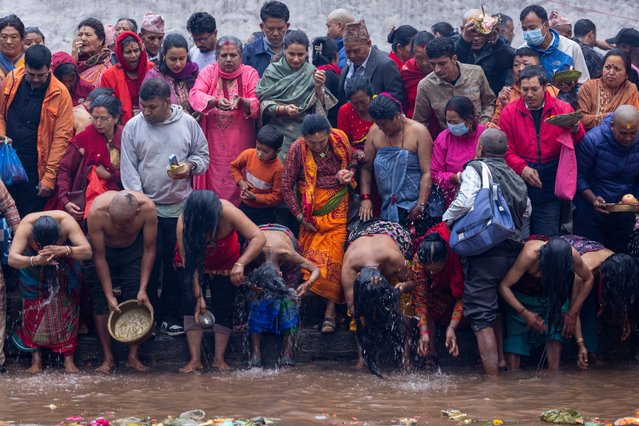
Nepalese people commemorate their late mothers by taking a bath at the sacred Matatirtha Shrine pond on the outskirts of Kathmandu, Nepal, 08 May 2024. In Nepal on Mother's Day, children show their gratitude by bringing their mothers presents, but those who have no mother traditionally visit the Matatirtha Shrine for a commemoration. (Photo by Narendra Shrestha/EPA/EFE)
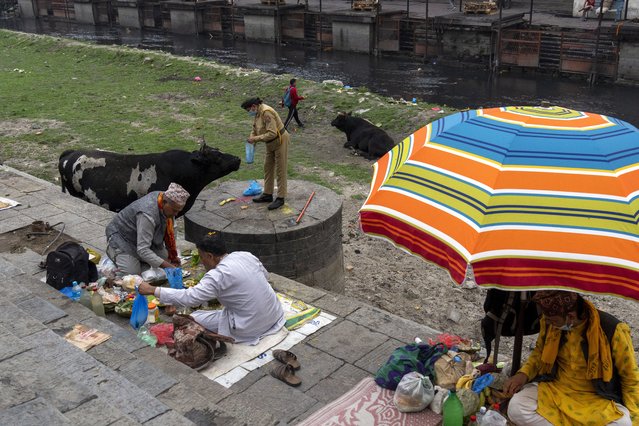
A Nepalese police woman feeds a bull as Hindu devotees perform rituals at the Pashupatinath temple premises on Matatirtha Aunshi or Mother's Day in Kathmandu, Nepal, Wednesday, May 8, 2024. (Photo by Niranjan Shrestha/AP Photo)
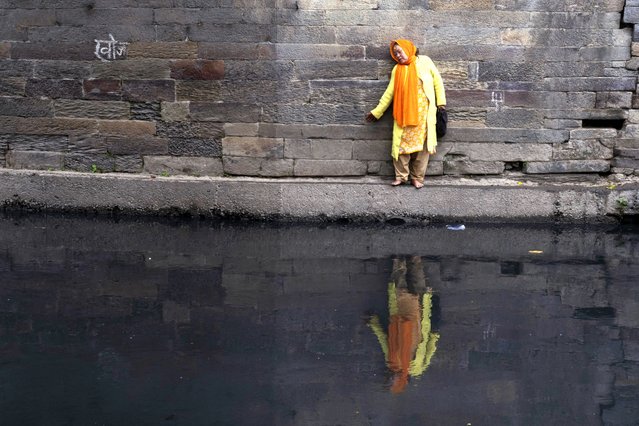
A Nepalese devotee makes her way back through a narrow ledge after offering prayers in front of an idol of Astamatrika, or eight mother goddesses, on the banks of the Bagmati river in Kathmandu, Nepal, Wednesday, May 8, 2024. Devout Hindus in Nepal are performing rituals on Wednesday to mark Matatirtha Aunshi or Mother's Day. (Photo by Niranjan Shrestha/AP Photo)

A member of the transgender community wears make-up at the backstage of Miss Pink Pageant in Kathmandu on May 16, 2024. (Photo by Prakash Mathema/AFP Photo)
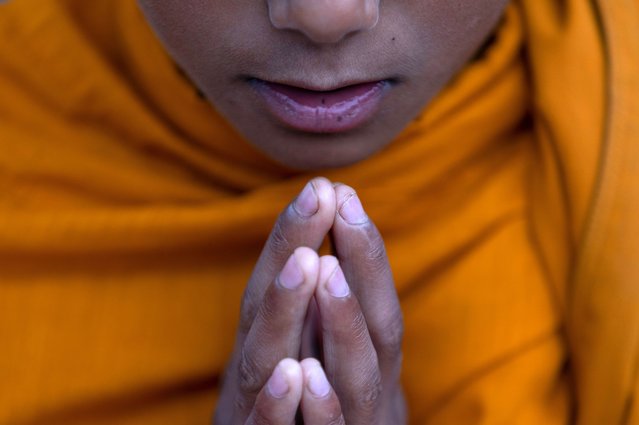
A Nepalese Buddhist monk chants prayer mantras during celebrations marking the Buddha's birthday in Kathmandu, Nepal, 23 May 2024. Thousands of Buddhist and Hindu devotees flocked to the temple to observe the traditional birthday of Buddha, or Prince Siddhartha Gautama, who was born about 2,500 years ago in Lumbini, now in Nepal, and is worshipped by people throughout Asia. (Photo by Narendra Shrestha/EPA/EFE)
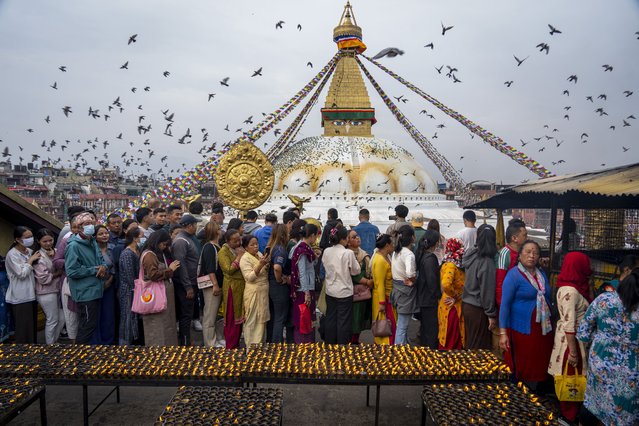
Buddhist devotees stand in a queue to light butter lamps during Buddha Jayanti or Buddha Purnima festival at the Boudhanath Stupa in Kathmandu, Nepal, Thursday, May 23, 2024. (Photo by Niranjan Shrestha/AP Photo)
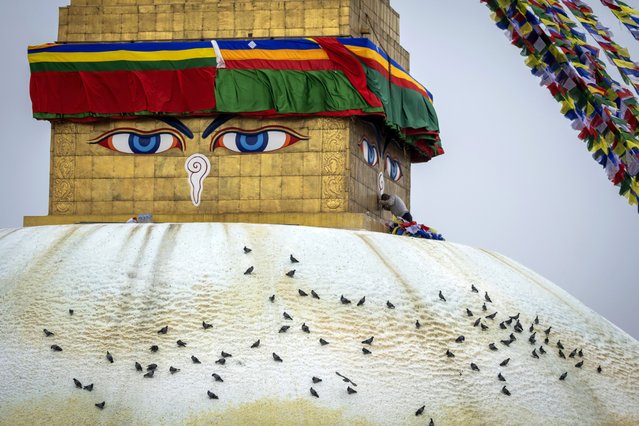
A Buddhist devotee offers prayers during Buddha Jayanti or Buddha Purnima festival at the Boudhanath Stupa in Kathmandu, Nepal, Thursday, May 23, 2024. (Photo by Niranjan Shrestha/AP Photo)

Renowned Sherpa mountain guide Kami Rita returning from Mount Everest after his record 30th successful ascent, waves after he arrives at the airport in Kathmandu, Nepal, Friday, May 24, 2024. (Photo by Niranjan Shrestha/AP Photo)

Phunjo Lama, who broke the world record for the fastest ascent of Mount Everest by a woman, is greeted by a crowd at an airport in Kathmandu, Nepal, on Sunday, May 26, 2024. Her journey from Everest Base Camp to the top took 14 hours and 31 minutes, then the descent from Everest was another nine hours and 18 minutes. (Photo by Prakash Mathema/AFP Photo)
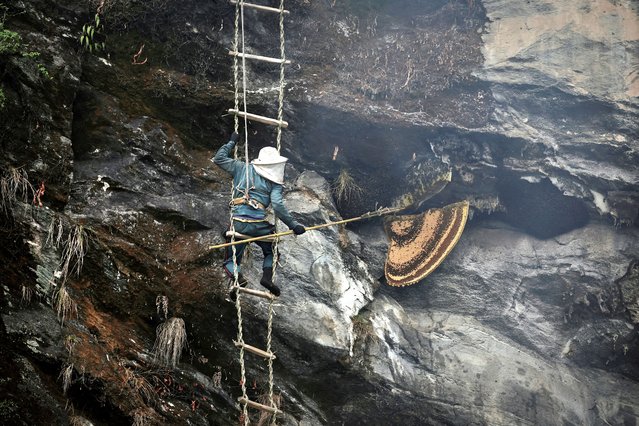
Aita Prasad Gurung, 40, cuts a honeycomb as he hangs onto a ladder made by villagers using bamboo and tree trunks, while harvesting honey from the cliff near Taap in Lamjung, Nepal, May 29, 2024. Aita dangled off a cliff, carefully manipulating a long pole with a blade at its end to cut away chunks of honeycomb after Himalayan bees fled the fumes from a fire set to drive them from their homes. He wore a white hat with a net swathing his face to protect against stings as he hung 160 feet (50m) off the precipice on a handmade ladder, braided from bamboo strands, to reach the bee colonies. (Photo by Navesh Chitrakar/Reuters)
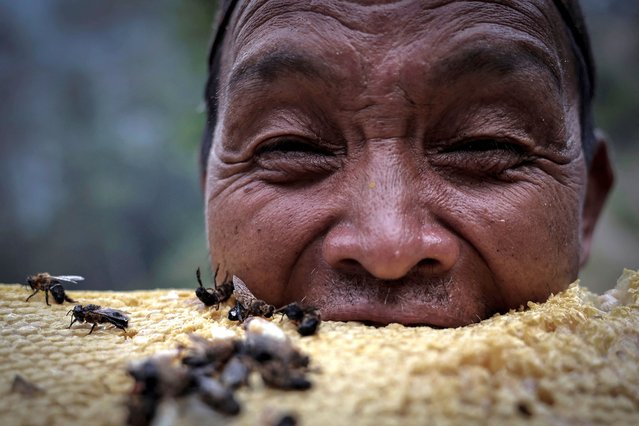
Tek Prasad Gurung, 64, takes a bite from freshly-harvested honeycomb during honey hunting near Taap in Lamjung, Nepal, on May 29, 2024. The honeycomb extract, also known as 'mad honey', for some intoxicating qualities that can cause hallucinations, sells for 2,000 Nepali rupees (1.5 USD) a litre, but the villagers rule out overharvesting as a reason for falling collections. (Photo by Navesh Chitrakar/Reuters)
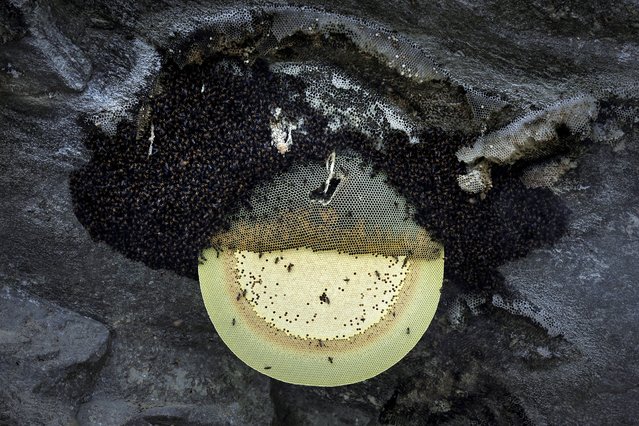
A portion of a honeycomb is exposed, after villagers lit a fire that made a cloud of smoke to ward off the bees from the hive, during honey hunting at the cliff near Taap in Lamjung, Nepal, on May 29, 2024. The honeycomb extract, also known as 'mad honey', for some intoxicating qualities that can cause hallucinations, sells for 2,000 Nepali rupees (1.5 USD) a litre, but the villagers rule out overharvesting as a reason for falling collections. (Photo by Navesh Chitrakar/Reuters)
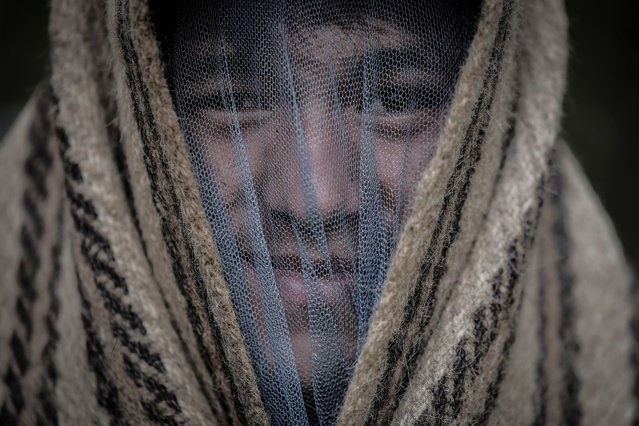
Aakhit Gurung, 17, covers his face using a net as he arrives to observe the honey hunting at the cliff near Taap in Lamjung, Nepal, on May 29, 2024. For generations, the Gurung community in Taap, about 175 km (110 miles) west of the capital, Kathmandu, and other villages in the nearby districts of Lamjung and Kaski, have scoured the steep Himalayan cliffs for honey. The proceeds, split among the group, are drying up as the number of hives declines, said the villagers, although some earn a living from growing crops of rice, corn, millet and wheat. With less honey available to collect every year, income from the pursuit has declined over the past decade. (Photo by Navesh Chitrakar/Reuters)
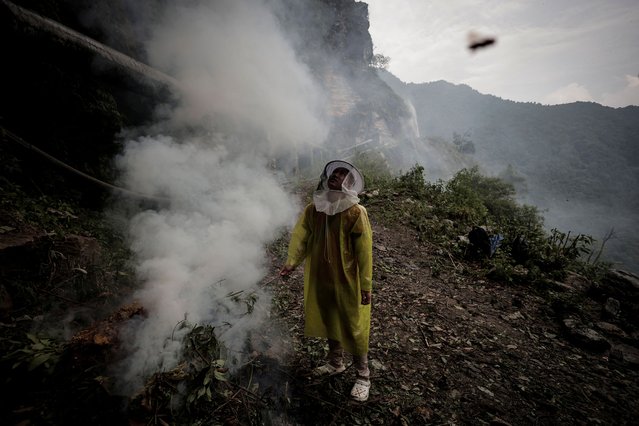
A villager tends to a fire made to create smoke, which will drive bees away from the hives, during honey hunting at the cliff near Taap in Lamjung, Nepal, on May 29, 2024. Temperatures in the Himalayas, home to the planet's tallest peaks, range higher than an average global increase of 1.2 degrees Celsius (2.2 degrees Fahrenheit) above pre-industrial levels, United Nations data and independent research show. Global studies show that a temperature rise of even one degree affects the growth of bees, the availability of their food and cross pollination of plants, said Suruchi Bhadwal of India's Energy and Resources Institute (TERI). (Photo by Navesh Chitrakar/Reuters)
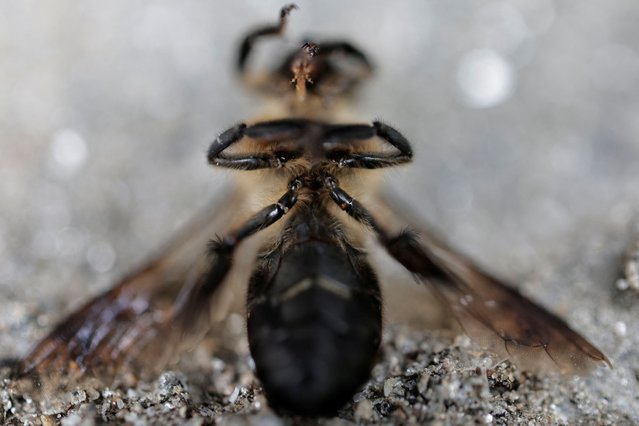
A dead bee lays on the ground below the cliff near Taap in Lamjung, Nepal, on May 29, 2024. Temperatures in the Himalayas, home to the planet's tallest peaks, range higher than an average global increase of 1.2 degrees Celsius (2.2 degrees Fahrenheit) above pre-industrial levels, United Nations data and independent research show. Global studies show that a temperature rise of even one degree affects the growth of bees, the availability of their food and cross pollination of plants, said Suruchi Bhadwal of India's Energy and Resources Institute (TERI). (Photo by Navesh Chitrakar/Reuters)
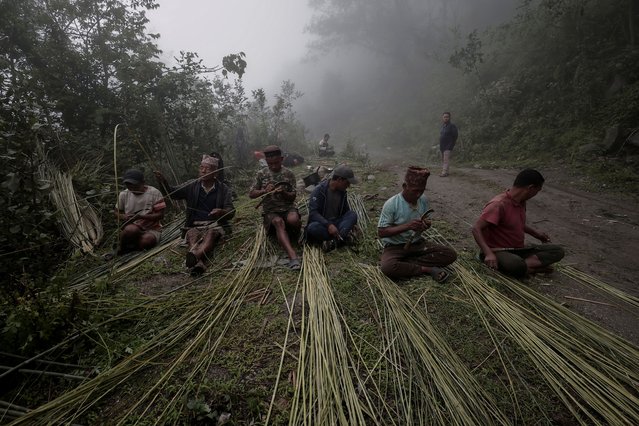
Villagers cut bamboo into thin strips to make rope for the ladder used during honey hunting near Taap in Lamjung, Nepal, on May 28, 2024. For generations, the Gurung community in Taap, about 175 km (110 miles) west of the capital, Kathmandu, and other villages in the nearby districts of Lamjung and Kaski, have scoured the steep Himalayan cliffs for honey. The proceeds, split among the group, are drying up as the number of hives declines, said the villagers, although some earn a living from growing crops of rice, corn, millet and wheat. With less honey available to collect every year, income from the pursuit has declined over the past decade. (Photo by Navesh Chitrakar/Reuters)

Nepalese cricket fans react while watching the public live broadcast of the T20 Cricket World Cup match Nepal vs South Africa in Kathmandu, Nepal,15 June 2024. South Africa won the match by one run. (Photo by Narendra Shrestha/EPA)
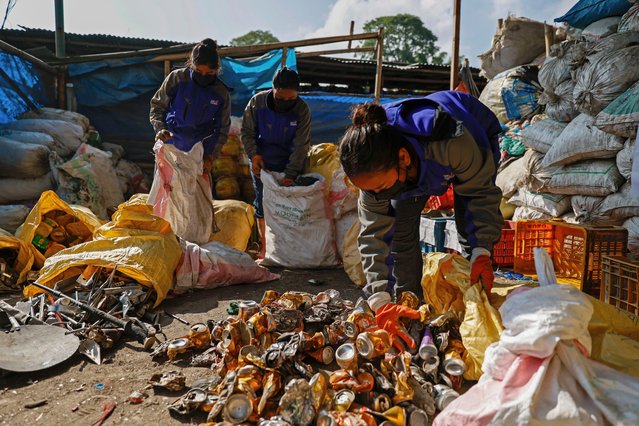
Workers segregate the garbage collected en route Mount Everest, at a facility operated by Agni Ventures, an agency that manages recyclable waste, in Kathmandu, Nepal, Monday, June 24, 2024. The Nepal government-funded team of soldiers and Sherpas removed 11 tons (24,000 pounds) of garbage, four dead bodies and a skeleton from Everest during this year's climbing season. (Photo by Sanjog Manandhar/AP Photo)
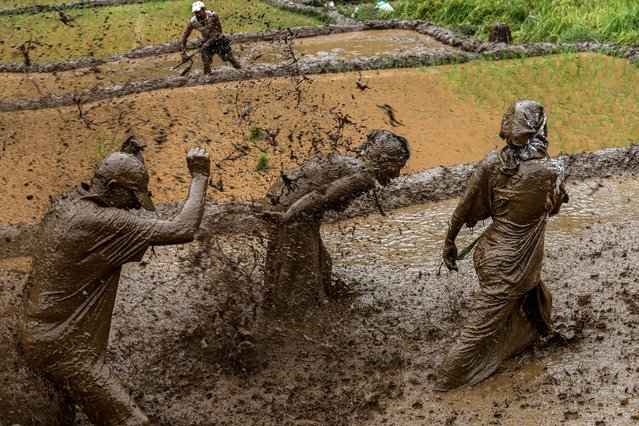
Farmers play with mud as they plant rice on “National Paddy Day of Nepal” in Dhading district on June 29, 2024. (Photo by Prakash Mathema/AFP Photo)
12 Jul 2024 04:49:00,
post received
0 comments
